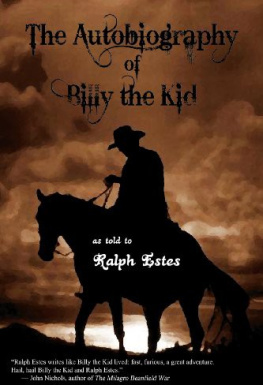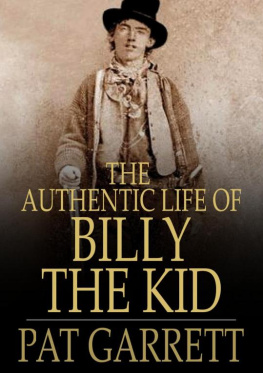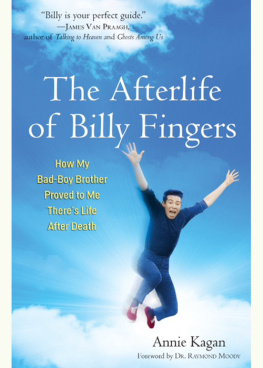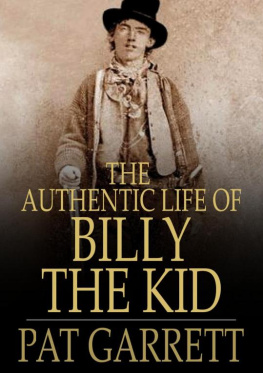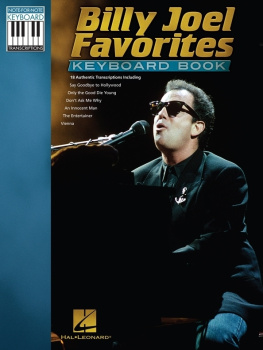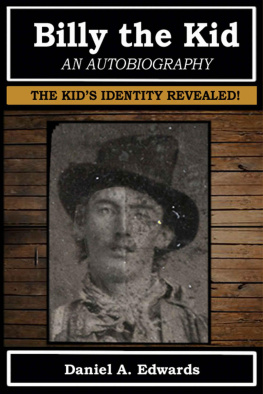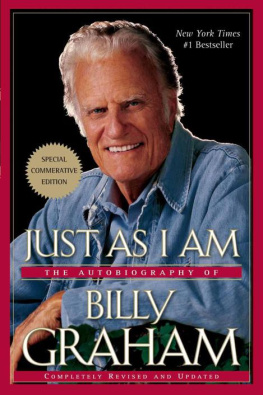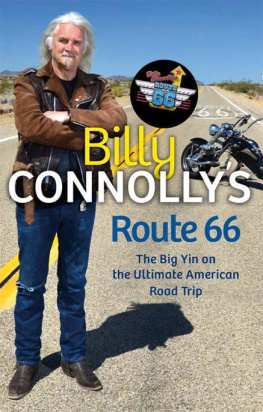The Autobiography ofBilly the Kid
as told to RalphEstes
Copyright Ralph Estes2012
Published by Black RoseWriting, Publishing at Smashwords
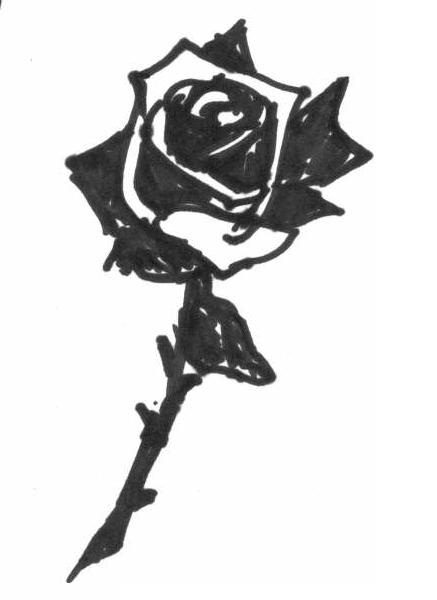
Black Rose Writing
www.blackrosewriting.com
* * * * *
2012 by Ralph Estes
All rights reserved. No part of thisbook may be reproduced, stored in a retrieval system or transmittedin any form or by any means without the prior written permission ofthe publishers, except by a reviewer who may quote brief passagesin a review to be printed in a newspaper, magazine orjournal.
The final approval for this literarymaterial is granted by the author.
First digital version
All characters appearing in this workare fictitious. Any resemblance to real persons, living or dead, ispurely coincidental.
Print ISBN:978-1-61296-139-2
PUBLISHED BY BLACK ROSEWRITING
www.blackrosewriting.com
Print edition produced in the UnitedStates of America
* * * * *
Contents
How This Book Came to Be
My Life, by Billy the Kid as told to RalphEstes
When Billy the Kid was Really a Kid
Silver City
Arizona: My First Killing
New Mexico: A New Start
Tunstall is Murdered, and the Lincoln CountyWar is On
We Catch Two of the Murderers
CuttingOff the Snake's Head
The Battle of Blazers Mill
Licking Our Wounds
The Five-Days Battle
They Burn Us Out, Kill McSween
After the War
The Tragic Peace Parley
On the Run
Caught!
The Trial
Escape From Lincoln
July 14, 1881: Quien Es?
List of Appendices
I. Who Was Who
II. Significant Places
III. The Lincoln County War, in short
IV. Frank Warner Angel Report, Department ofJustice: In the Matter of the Cause and Circumstances of the Deathof John H. Tunstall, a British Subject
V. Frank Warner Angel Report, Department ofJustice: In the Matter of the Lincoln County Troubles, To theHonorable Charles Devens, Attorney General
VI. Selected Books
VII. Original letters
Resources
* * * * *
My name is William Bonney
And I have some things to tell
All about my life and death
And the way things are in hell
And the lies they told about me
After Garrett shot me down
In New Mexico
In eighteen eighty-one
Dave Stamey, The Skies of LincolnCounty
Billy the Kid! Famous outlaw, bloodthirstykiller, scourge of Lincoln County and the terror of the West, aname to frighten recalcitrant kids into behaving.
Killed his first man when he was onlytwelve, to avenge an insult to his mother.
Went on to kill at least twenty-one men, onefor each notch on his gun and each year of his young life notcounting Mexicans and Indians.
Lived in a magnificent cavern in Eastern NewMexico with crystal chandeliers, Persian carpets, elaborate feastsserved by one hundred beautiful senoritas.
Chased down and captured, tried, convicted,sentenced to hang. Then shot both his guards in an incredibleescape.
Finally killed by his nemesis and formerfriend, Sheriff Pat Garrett, in a darkened bedroom in Fort Sumner,New Mexico.
Or not?
The story of Billy the Kid has beentold many times. Sometimes its an outlandish fantasy, such as PatGarretts own book The Authentic Life ofBilly of Kid , or the multitude of Hollywood creations over sixty movies.
Other times its a work of serious history except that much of the history has had to be imagined because ofconflicting evidence or no evidence at all. So such works oftendisagree.
This book is not another attempt to tellthat history.
This book tells Billys side. Why he didwhat he did, what choices he saw, what he felt. His yearnings, hisjoys, his regrets. Billys own story, in his own words.
How This Book Came toBe
Billy the Kid didnt die of Pat Garrettsbullet on July 14, 1881. He was shot, but he didnt die.
When Deluvina Maxwell entered Pete Maxwellsbedroom alone, because Pete and Pat Garrett were afraid to goback in after the shooting she discovered Billy on the floor,badly wounded. As Billy let out a low groan, Deluvina quicklygrasped the possibilities and urgently whispered, Play dead,Billy, play dead.
Though in great pain, Billy held himselfmotionless as Deluvina and friends moved and then dressed his body,attended him through the night, laid him in a coffin with contrivedair holes, and at daybreak lowered him into the grave. Delays, toreposition the corpse, to re-hammer the top more tightly, tobring the coffin back up for Deluvina to place a Bible with Billy,led a very nervous Garrett to take off skin out in the parlanceof the day as the first shovelful of dirt fell. Garrett evidentlyfeared for his life, for he was amidst Billys loyal friends.
With Garrett gone, Billy was brought out ofthe grave and spirited away to a nearby ranch for recuperation. Heeventually made his way to Wichita where he had lived happily withhis mother and brother as a child. There, under the name of HenryCarter, he lived to a ripe old age.
Then in 1951, the Wichita newspaperpublished an article about Ralph Estes, a local high schoolstudent. The piece caught one very important eye that of HenryCarter.
Carter, still living in Wichita but nowdying with cancer and in a senior care facility, saw the articleand was much impressed by Ralphs analysis. The young lad hadcaptured almost exactly what Henry in his days as Billy the Kid was thinking in 1878 at the start of the Lincoln County War.
Henry asked the facility to get Ralph tocome and see him. They talked at length about regulator movementsand the role of such citizen movements in the quest for justice inthe formative years of the country.
Henry at last decided to reveal his realhistory to Ralph, but first swearing Ralph to tell no one untilafter his death.
Over some two weeks Ralph visited Henryalmost every day, with a borrowed tape recorder.
As Henry grew weaker he became desperate tofinish the story, and the sessions lengthened. Finally he got toFort Sumner in July 1881, telling of his escape and how he workedhis way back to Wichita. Pleading great fatigue, he refused to talkin more detail about his life after Billy, though those who knewhim would later say he was just an ordinary citizen, living andworking and becoming a member of the community.
Two days later Henry Carter died.
The tapes were stashed in a box in Ralphsparents house for years as a teenage boy other things were moreinteresting than musty history. But much later, while dealing withthe house and residue of his parents estate, Ralph uncovered thebox of tapes. He now realized that nothing could be moreinteresting than transcribing Billys true life story.
Except for minor editorial adjustments, whatfollows are Billy the Kids own words.
My Life, by Billy the Kid as told to Ralph Estes
So much has been written about me, my life,the things I did. Of course after 1881 nobody ever asked me becausethey couldnt. Everyone thought I was dead. And I wanted them tokeep on believing that.
Most of what you may have heard aboutme came from a book, The Authentic Life ofBilly, the Kid , by the man that shot me, Pat Garrett.Garrett, and his friend Ash Upson who actually wrote most of it,tried to make me into the biggest, baddest, boldest outlaw thatever lived, probably to justify Garretts ambushing me in thedark.
That book has me, as a 12-year-old kid,killing a man for insulting my mother and a few weeks later killingthree Apaches. After that I was supposed to have killed a gamblerin Sonora and a monte dealer in Chihuahua City, saved a family bykilling eight Indians, killed two more Apaches plus MorrisBernstein and Joe Grant. Pretty wild, huh? Reads like a comicbook.
Next page
